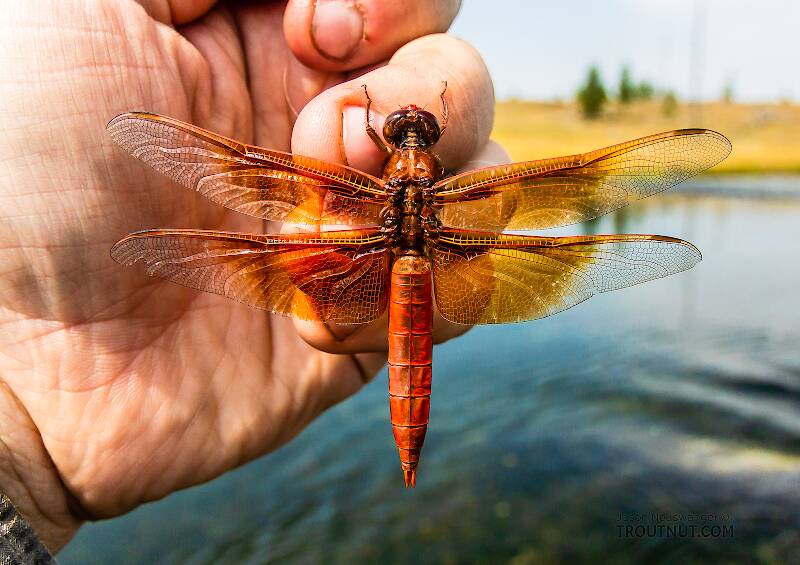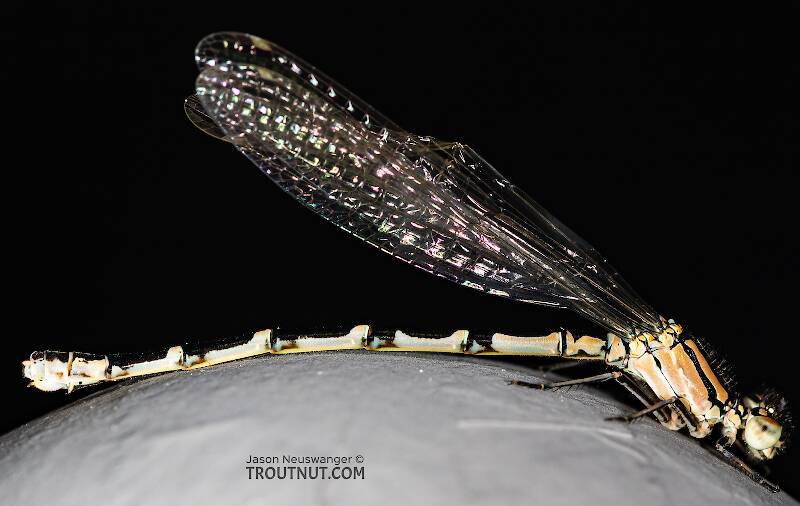
Hex Mayflies
Hexagenia limbata
The famous nocturnal Hex hatch of the Midwest (and a few other lucky locations) stirs to the surface mythically large brown trout that only touch streamers for the rest of the year.
Featured on the forum

This one seems to tentatively key to Holocentropus, although I can't make out the anal spines in Couplet 7 of the Key to Genera of Polycentropodidae Larvae nor the dark bands in Couplet 4 of the Key to Genera of Polycentropodidae Larvae, making me wonder if I went wrong somewhere in keying it out. I don't see where that could have happened, though. It might also be that it's a very immature larva and doesn't possess all the identifying characteristics in the key yet. If Holocentropus is correct, then Holocentropus flavus and Holocentropus interruptus are the two likely possibilities based on range, but I was not able to find a description of their larvae.

Troutnut is a project started in 2003 by salmonid ecologist Jason "Troutnut" Neuswanger to help anglers and
fly tyers unabashedly embrace the entomological side of the sport. Learn more about Troutnut or
support the project for an enhanced experience here.
Identification: Key to Orders of Adult Aquatic Insects, Couplet 13
Identification: Key to Orders of Adult Aquatic Insects, Couplet 13
Error: Tried to access a key that isn't live.
Both parts of this couplet lead to the order Odonata, and this couplet separates the two suborders Anisoptera (Dragonflies) and Zygoptera (Damselflies). It's arranged this way because "suborder" is not a taxonomic level included in this site's programming, but it's an important everyday classification in this one case.
| Option 1 | Option 2 |
|---|---|
| Wings held together above abdomen or only partly spread when insect is perched | Wings held horizontally when insect is perched |
| Eyes separated by more than the width of one eye | Eyes meeting middorsally or separated by a space less than the width of one eye |
| Fore and hind wings similar in size and shape, each with a quadrangle instead of a triangle and subtriangle | Fore and hind wings dissimilar in size and shape, with hind wing considerably wider at base than forewing; each with a triangle and subtriangle |
| Males with 2 paraprocts | Males with an epiproct which is either entire or bifid |
| Females with a fully-developed ovipositor, bearing styli | Females with or without an ovipositor |
1 Example Specimen | 1 Example Specimen
This specimen of Libella saturata, the flame skimmer dragonfly, is the only invertebrate in this site's collection that I caught by hook and line. It swooped down and attacked my dry fly on the Firehole River, where it lived as a nymph in the hot water near the geothermal springs and geyser runoff.
|
| Odonata-Zygoptera | Odonata-Anisoptera |
Adapted from Merritt R.W., Cummins, K.W., and Berg, M.B. (2019)
The current couplet is highlighted with darker colors and a icon, and couplets leading to this point have a icon.
Leads to Couplet 2:
- Forewings leathery (semiopaque) or hard, at least in the basal half
Couplet 2
Leads to Couplet 4:
- Wings entirely membraneous, usually transparent between veins, but may be variously colored, darkened, or covered with hairs or scales
Couplet 4
Leads to Orthoptera:
- Forewings leathery, with distinct veins
- Femora of hind legs greatly enlarged, suited for jumping
Leads to Coleoptera:
- Forewings hard (called elytra), with veins indistinct; hindwings membraneous but often concealed
- Hind legs suited for walking or swimming
Leads to Couplet 5:
- One pair of wings
Couplet 5
Leads to Couplet 6:
- Two pairs of wings, although hindwings may be small or concealed beneath forewings when wings are folded
Couplet 6
Leads to Ephemeroptera:
- Two or three tails
- Mouthparts inconspicuous
- Thorax without halteres
Leads to Couplet 7:
- Wings covered with scales or hairs, obscuring venation
Couplet 7
Leads to Couplet 8:
- Wings bare or with minute hairs; venation clearly visible
Couplet 8
Leads to Lepidoptera:
- Wings covered with scales (broadly flattened hairs)
- Mouthparts usually fitted with a coiled sucking tube (proboscis)
Leads to Trichoptera:
- Wings covered with hairs
- Mouthparts without a coiled sucking tube
Leads to Couplet 9:
- Antennae bristle-like and inconspicuous, usually shorter than head
Couplet 9
Leads to Couplet 10:
- Antennae of various shapes, conspicuous, and not bristle-like, and usually much longer than head
Couplet 10
Leads to Ephemeroptera:
- 2 or 3 tails
- Hind wings much smaller than forewings
Leads to Couplet 13:
- No tails
- Wings about equal in size
Couplet 13
Leads to Plecoptera:
- Tarsi 2- or 3-segmented
- 2 conspicuous tails (except reduced in some Nemouridae)
Leads to Couplet 11:
- Tarsi 5-segmented (except a few Hymenoptera have 3 or 4 segments)
- No tails
Couplet 11
Leads to Couplet 12:
- Abdomen broadly joined to thorax
- Front margin of forewing in basal half with many small veins perpendicular to edge
- Wings with more than 20 closed cells
Couplet 12
Leads to Hymenoptera:
- Abdomen with narrow constriction at junction with the thorax
- Marginal veins in basal half of forewing parallel to leading edge
- Wings with fewer than 20 closed cells
- Aquatic forms are very small, usually less than 3 mm long
Leads to Megaloptera:
- Hind wings pleated lengthwise, folded fan-like when closed
- Veins along back edge of wings usually with Y-shaped branches
Leads to Neuroptera:
- Hind wings not pleated, similar to forewings when closed
- Veins along back edge of wings forming many Y-shaped branches
Neuroptera
Couplet 13 (You are here)
Leads to Odonata-Zygoptera:
- Wings held together above abdomen or only partly spread when insect is perched
- Eyes separated by more than the width of one eye
- Fore and hind wings similar in size and shape, each with a quadrangle instead of a triangle and subtriangle
- Males with 2 paraprocts
- Females with a fully-developed ovipositor, bearing styli
Leads to Odonata-Anisoptera:
- Wings held horizontally when insect is perched
- Eyes meeting middorsally or separated by a space less than the width of one eye
- Fore and hind wings dissimilar in size and shape, with hind wing considerably wider at base than forewing; each with a triangle and subtriangle
- Males with an epiproct which is either entire or bifid
- Females with or without an ovipositor
Start a Discussion of this Couplet
References
- Merritt R.W., Cummins, K.W., and Berg, M.B. 2019. An Introduction to the Aquatic Insects of North America (Fifth Edition). Kendall/Hunt Publishing Company.
Orders excluded
These orders of Insecta are not included in this key: Psocodea
Description of this key
This key allows identification to order of adult aquatic and semiaquatic insects. Be aware that some invertebrates you might find (including crustaceans, springtails (Collembola), and worms) are not included here. Adult aquatic insects generally have wings present, usually fully developed, conspicuous, and movable, and legs present.


